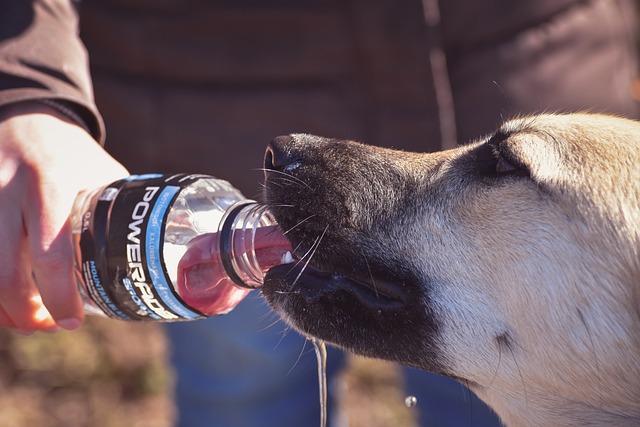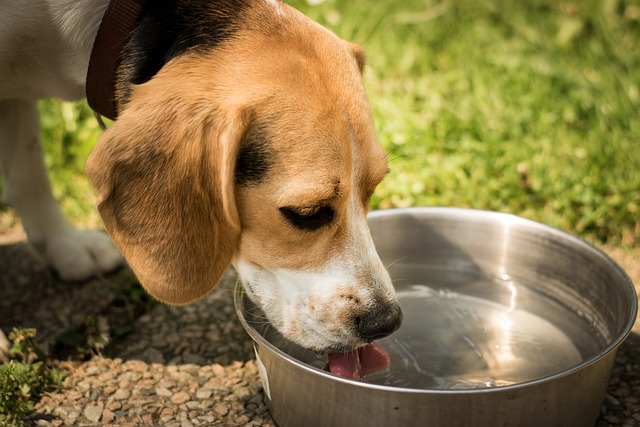Heat Stroke in Dogs: Treatment and Prevention
Posted: 11/06/2023 | BY: Erin Cain | Categories: Uncategorized
Summer means sun, fun, and family activities, and more pet parents than ever are bringing their dogs to the party. While time outdoors provides canines with plenty of enrichment and engagement, time outside in heat, humidity, and high temperatures can result in heat stroke, a recipe for disaster.

Humans aren’t the only ones who feel the heat; dogs do, too, and they have two biological methods of cooling themselves in hot weather. Canines pant as a means of lowering their body temperature, and they sweat through their paws. However, these processes can only do so much in the face of significant heat. A dog exposed to high heat and temperatures may develop heat stroke, a life-threatening condition. By learning about this condition and how to prevent and treat it, you can ensure that your pup enjoys his time outdoors this summer in a safe manner.
What is heat stroke?
Heat stroke is a deadly illness when a dog’s heat-dissipating abilities are unable to accommodate excessive heat and high temperatures. This illness typically happens when a dog’s core body temperature exceeds 105.8℉, although that exact number is not a necessity for the onset of heat stroke.
Substantially high temperatures or lengthy periods of heat exposure can result in the dysfunction of a dog’s bodily systems and increase the risk of death. Additionally, heat stroke affects dogs in different ways. Some dogs will experience life-threatening blood and cell, cardiac, and renal disorders, while others may experience organ dysfunction.
Heat stroke is a common condition in dogs, and it can occur quickly, particularly in environments where there are high temperatures and humidity or in places with little to no ventilation. Humidity between 35-80% can harm or entirely negate a dog’s natural cooling systems.

When heat stroke occurs in a dog, the following system failures happen:
- As temperatures rise, the dog’s brain swells and may bleed in some areas.
- Gastrointestinal dysfunction occurs.
- In response to the heat stroke, the dog’s heart cardiac output increases and blood vessels dilate, risking cardiac arrest.
- Renal failure and liver and muscle damage result, leading to permanent damage or death.
Dogs are susceptible to two types of heat stroke: exertional and non-exertional. Let’s look at these heat stroke forms and how they occur in dogs.
Exertional heat stroke
Exertional heat stroke happens while a dog is exercising (running, walking, or playing) in conditions that are too hot for his body to respond to adequately. This type of heat stroke often happens with dogs who have not had the chance to become acclimated to their surrounding environment. It takes dogs around 90 days to become accustomed to a warmer climate, so gradually exposing them to the heat and humidity is a must for their well-being and health.
Non-exertional heat stroke
Non-exertional heat stroke occurs when a dog is unable to cool himself down due to increased temperatures in areas with decreased airflow, such as a home or apartment without air conditioning, a closed car, or a yard or park without adequate shade or water.

What are the signs of heat stroke?
There are a variety of signs and symptoms indicating a dog may have heat stroke. A dog in this condition may suffer from any of the following symptoms:
- Excessive or noisy panting
- Warm to the touch or feverish
- Hypersalivation (excessive drooling)
- Rapid heart rate
- Vomiting
- Diarrhea
- Confusion
- Lethargy
- Staggering (ataxia) or inability to walk
- Dry nose
- Blood in the mouth or stool
- Muscle tremors and weakness
- Fainting or collapse
- Bright red gums
- Seizure
- Coma
- Cardiac arrest
- Death within 24 hours
Which dogs are predisposed to heat stroke?
Some dogs are more likely to suffer from heat stroke than others. Puppies under six months old, senior dogs, and overweight and obese dogs are known for having difficulty in hot weather, making them prone to heat stroke. Certain medications and dogs who have lung or heart disease are in more danger of experiencing this condition. Additionally, if your dog has previously had a heat stroke, he is at high-risk if suffering from it again.
Breeds with thick, heavy coats, such as Siberian Huskies and Malamutes, are at higher risk of heat stroke. The same goes for breeds with “double-coats,” such as the Chow Chow and the Labrador Retriever and Golden Retriever. The extra dense and double-coats act as insulators and trap heat, a dangerous combination for these pups.
Perhaps the breeds most at risk for heat stroke are those least comfortable in warm and hot weather: the bracypehliac dogs. This canine category includes breeds like the Pug, French Bulldog, Boston terrier, and Cavalier King Charles spaniel amongst others. What do these breeds have in common? They all have flat-faces, which makes it harder for them to pant and cool down in hot temperatures. The hotter the environment, the harder these breeds work to pant and breathe. Heat stroke is often deadly for these flat-faced dogs.
How should you treat a dog with heat stroke?

What happens if you think your dog has heat stroke? Every minute is crucial in this situation, so take these steps to help your dog as quickly as possible:
Scenario 1. If these conditions are not present, take your dog to the nearest veterinarian or emergency animal hospital immediately:
- Your dog is unresponsive, collapsed, or having seizures;
- You don’t have access to cool water;
- Your dog is noticeably bruised, bleeding, experiencing diarrhea, or vomiting
Scenario 2:
- Move your dog into a shady, cool area or air-conditioned environment.
- Place a wet, cool blanket or towel underneath him.
- If he is awake and able to drink water, give him small amounts of cool — not cold — water frequently; don’t let him drink too much too fast as this can result in other medical conditions.
- Make a note of the time at which you begin treating your dog so you can let your veterinarian know how much time has passed since the heat stroke began.
- If you have a rectal thermometer, take your dog’s temperature. If his temperature is above 104℉, spray, hose, or sponge his body with cool water.
- If you have a fan nearby, turn it on your dog and let it blow on him.
- Stop spraying when your dog’s temperature drops to 103.5℉. Do not cool past this point as your dog can go into further shock.
- Note the time when you stop cooling your dog, again for your veterinarian’s reference and your pup’s future medical treatment.
- Use a dry towel or blanket to dry your dog slightly and prevent excessive cooling.
- Take your dog to the nearest veterinary clinic or emergency animal hospital for further medical care.
Whether you feel prepared to help your dog during a heat stroke or not, the veterinarian is always the last step in either scenario. If in doubt, take your dog straight to the nearest veterinary clinic for medical assistance.
Keep your dog safe this summer.
Pet parent education is the best prevention for canine heat stroke. You can lower the chances your dog experiences heat stroke in these ways:
- Take up to 2 months to acclimate your dog to hot temperatures.
- Never leave your dog inside a parked car, even for a few moments or with the windows cracked.
- Exercise your dog only during cooler parts of the day (early morning and later evening).
- Make sure your dog has access to plenty of drinking water and shade when outdoors.
- Keep your house cool; if you have air conditioning, leave it on for your dog even when you are not home.
- Carefully observe your dog for signs and symptoms of heat stroke when he is indoors and outdoors.
Heat stroke can happen to any dog, and rushing your dog to a veterinary clinic in an emergency can potentially cost thousands of dollars. Make sure your dog has pet insurance coverage so you can worry about his health rather than how much his treatment will cost. Get a quote today, and make sure that you and your pup can enjoy the dog days of summer together.
References:
- Goldbaum, K. (2016). Do Dogs Sweat? Retrieved from https://www.livescience.com/55553-do-dogs-sweat.html
- Lengyel, K. (2018). The 3-Tiered Approach of Treating Heatstroke in Dogs. Retrieved from https://www.americanveterinarian.com/news/the-3tiered-approach-of-treating-heatstroke-in-dogs
- T., V. (2020). Canine Heat Stroke. Retrieved from https://www.iowaveterinaryspecialties.com/student-scholars/canine-heat-stroke-literature-review
- Dewhirst, T. (2019). Keeping a Dog Cool & Avoiding Heat Stroke. Retrieved from https://www.eukanuba.com/dog-articles/dog-health/keeping-dogs-cool
- McGreevy, P., Fawcett, A. (2019). Vets can do more to reduce the suffering of flat-faced dog breeds. Retrieved from https://theconversation.com/vets-can-do-more-to-reduce-the-suffering-of-flat-faced-dog-breeds-110702
Disclaimer
The information contained on this blog is intended for informational and educational purposes only and should not be construed as medical advice. It is not a substitute for professional veterinary care. Always consult with your veterinarian before making any changes to your pet's health care or treatment plan.
The authors of this blog are not veterinarians and do not claim to be experts in pet health. The information provided here is based on our own experiences and research, as well as information from reputable sources. However, we cannot guarantee the accuracy or completeness of this information.
We encourage you to do your own research and consult with your veterinarian before making any decisions about your pet's health.
Previous post
5 Safety Tips for Walking Your Dog in the DarkNext post
5 Spring Safety Tips for DogsCompare top pet insurance providers plans.
Enter your dog’s age in years and months to calculate their age equivalent to human years.
Calculate your dog’s ageEnter your cat’s age in years and months to calculate their age equivalent to human years.
Calculate your cat’s age